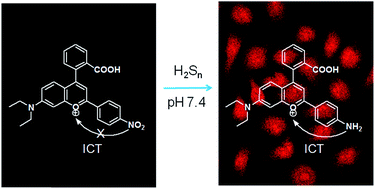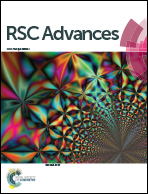A flavylium-based turn-on fluorescent probe for imaging hydrogen polysulfides in living cells†
Abstract
As newly discovered intracellular reactive sulfur species, hydrogen polysulfides (H2Sn, n > 1) have attracted increasing attention because of emerging studies showing that H2Sn instead of H2S is the actual signaling molecule in living systems. Developing efficient methods to detect H2Sn will contribute to the investigation of their biosynthetic pathway, functions and mechanisms of action. In this work, 2-(4-nitrophenyl)-4-(2-carboxyphenyl)-7-diethylamino-1-benzopyrylium (1) was developed as a turn-on fluorescent probe for H2Sn. The design strategy takes advantage of the facile reduction of the nitro group within probe 1 by H2Sn to the corresponding amino group, thus retrieving the intramolecular charge transfer (ICT) process within the dye and resulting in a 87-fold fluorescence enhancement. Probe 1 displays high selectivity toward H2Sn over other abundant competing biothiols, such as glutathione and cysteine. The intracellular imaging studies indicate that the proposed probe possesses excellent membrane penetrability and is suitable for visualizing H2S2 in living cells.


 Please wait while we load your content...
Please wait while we load your content...